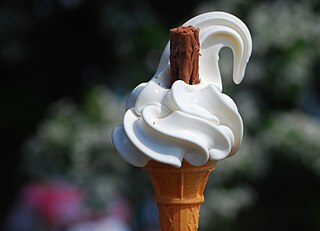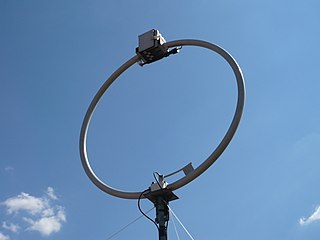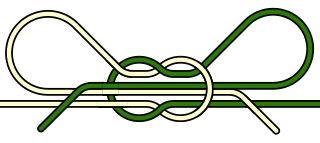
A 99 Flake can refer to any of three possible items: an ice cream cone with a Cadbury Flake inserted in it; the Cadbury-produced Flake bar itself specially made for insertion into an ice cream cone; or a wrapped ice cream cone product marketed by Cadbury.

Chocoladefabriken Lindt & Sprüngli AG, more commonly known simply as Lindt, is a Swiss chocolatier and confectionery company founded in 1845 and known for its chocolate truffles and chocolate bars, among other sweets.

Direction finding (DF), or radio direction finding (RDF), is the measurement of the direction from which a received signal was transmitted. This can refer to radio or other forms of wireless communication, including radar signals detection and monitoring (ELINT/ESM). By combining the direction information from two or more suitably spaced receivers, the source of a transmission may be located via triangulation. Radio direction finding is used in the navigation of ships and aircraft, to locate emergency transmitters for search and rescue, for tracking wildlife, and to locate illegal or interfering transmitters. RDF was important in combating German threats during both the World War II Battle of Britain and the long running Battle of the Atlantic. In the former, the Air Ministry also used RDF to locate its own fighter groups and vector them to detected German raids.

The Easter Bilby is an Australian alternative to the Easter Bunny.

A loop antenna is a radio antenna consisting of a loop or coil of wire, tubing, or other electrical conductor usually fed by a balanced source or feeding a balanced load. Within this physical description there are two distinct antenna types:

A television antenna is an antenna specifically designed for use with a television receiver (TV) to receive over-the-air broadcast television signals from a television station. Terrestrial television is broadcast on frequencies from about 47 to 250 MHz in the very high frequency (VHF) band, and 470 to 960 MHz in the ultra high frequency (UHF) band in different countries. Television antennas are manufactured in two different types: "indoor" antennas, to be located on top of or next to the television set, and "outdoor" antennas, mounted on a mast on top of the owner's house. They can also be mounted in a loft or attic, where the dry conditions and increased elevation are advantageous for reception and antenna longevity. Outdoor antennas are more expensive and difficult to install, but are necessary for adequate reception in fringe areas far from television stations. The most common types of indoor antennas are the dipole and loop antennas, and for outdoor antennas the yagi, log periodic, and for UHF channels the multi-bay reflective array antenna.
Rabbit ears are the ears of a rabbit. Rabbit Ears or Rabbit ears may also refer to:

The Playboy Club was initially a chain of nightclubs and resorts owned and operated by Playboy Enterprises. The first club opened at 116 E. Walton Street in downtown Chicago, Illinois, United States, on February 29, 1960. Each club generally featured a Living Room, a Playmate Bar, a Dining Room, and a Club Room. Members and their guests were served food and drinks by Playboy Bunnies, some of whom were featured in Playboy magazine. The clubs offered name entertainers and comedians in the Club Rooms, and local musicians and the occasional close-up magician in the Living Rooms. Starting with the London and Jamaica club locations, the Playboy Club became international in scope. In 1991, the club chain became defunct. Thereafter, on October 6, 2006 a Playboy Club was opened in Las Vegas at the Palms Casino Resort, and in 2010 clubs were opened as well in Macao and Cancun. In time the Las Vegas club closed on June 4, 2012, the Macao club closed in 2013 and the Cancun club closed in 2014. In May 2014 the Commerce Casino in Los Angeles opened a Playboy themed lounge consisting of gaming tables and Playboy Bunny cocktail waitresses.

A quad antenna is a type of directional wire radio antenna used on the HF and VHF bands. Like a Yagi–Uda antenna ("Yagi"), a quad consists of a driven element and one or more parasitic elements; however in a quad, each of these elements is a loop antenna, which may be square, round, or some other shape. It is used by radio amateurs on the HF and VHF amateur bands.
Cadbury Dairy Milk Caramel is a chocolate bar that is part of the Cadbury Dairy Milk brand and is made by Cadbury UK and Cadbury Ireland. The bar is sold in the United Kingdom, Ireland, the United States, Australia and New Zealand.

The Abominable Snow Rabbit is a six-minute 1961 Warner Bros. Looney Tunes theatrical cartoon starring Bugs Bunny and Daffy Duck. The cartoon was directed by Chuck Jones and co-directed by Maurice Noble, with a story by Tedd Pierce. The cartoon's title is taken from the phrase and horror film The Abominable Snowman. It was the final original Chuck Jones theatrical cartoon with Daffy Duck.
Yogi the Easter Bear is an animated television special starring Yogi Bear and produced by Hanna-Barbera which was broadcast in syndication on April 3, 1994. This, along with Arabian Nights, was one of Don Messick's last voice-over roles; he suffered a debilitating stroke in 1996 and died in 1997.

Sugarbunnies are a character duo created by Sanrio in 2004. The duo are composed of twin bunnies called Shirousa and Kurousa, who specialize in making sweets and pastries. After the success of the franchise, Sanrio created more bunny twins who each specialize in their own jobs. They all live in the magical world of Bunniesfield.

A halo antenna, or halo, is a horizontally polarized, omnidirectional 1⁄2 wavelength dipole antenna, which has been bent into a loop with a small break on the side of the loop directly opposite the feed point. The dipole ends are close but do not meet, and may have an air capacitor between them as needed to establish resonance.

The shoelace knot, or bow knot, is commonly used for tying shoelaces and bow ties.

A double figure-eight loop, is a type of knot that forms two parallel loops, and resembles the figure-eight loop.
KTFO-CD, virtual channel 31, is a UniMás owned-and-operated television station licensed to Austin, Texas, United States. Owned by the Univision Local Media subsidiary of Univision Communications, it is sister to Killeen-licensed Univision owned-and-operated station KAKW-DT. The two stations share studios on North Loop Boulevard in Austin; KTFO-CD's transmitter is located at the West Austin Antenna Farm north of West Lake Hills.

Nesquik is a brand of products made by Swiss company Nestlé. In 1948, Nestlé launched a drink mix for chocolate-flavored milk called Nestle Quik in the United States; this was released in Europe during the 1950s as Nesquik.

Dwarf Hotot is a breed of domestic rabbit characterized by an entirely white coat, except for a circle of another color around each eye.
A chocolate bunny or chocolate rabbit is a piece of chocolate in the shape of a rabbit, usually stylized, and generally hollow. It is in some ways a variant of the chocolate Easter egg, being made in a mould in the same manner, both the egg and the rabbit symbolise new life, and spring. Specifically the production of such eggs for Easter is related to the Easter bunny.














